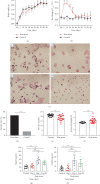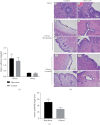Pathophysiological Changes in Female Rats with Estrous Cycle Disorder Induced by Long-Term Heat Stress
- PMID: 32685488
- PMCID: PMC7320282
- DOI: 10.1155/2020/4701563
Pathophysiological Changes in Female Rats with Estrous Cycle Disorder Induced by Long-Term Heat Stress
Abstract
High-temperature exposure is detrimental to women's reproductive health; however, the impact caused by long-term high temperature is not comprehensive, and a stable model of estrous cycle disorder induced by a high temperature is yet lacking. Herein, we aimed to establish a stable and effective model of estrous cycle disorder in female rats induced by long-term heat stress to study its physiological and pathological characteristics and explore the underlying mechanism. In the present study, female Sprague-Dawley rats with normal estrous cycles were exposed to the temperature of 38 ± 0.5°C, relative humidity (RH) of 55 ± 5% (2 h/d, 1 time/d) hot cabin at more than 90 days. Consequently, after long-term heat stress, no difference was detected in body weight and rectal temperature, but the estrus cycle was prolonged, the uterine organ index was increased, pathological changes occurred, the increase latitude of stress hormones heat shock protein 70 (Hsp70) and corticosterone (CORT) decreased, estradiol (E2) and luteinizing hormone (LH) levels decreased, follicle stimulating hormone (FSH) and prolactin (Prl) levels increased, gonadotropin-releasing hormone (GnRH) and thyroid hormone (T4) showed no difference, and insulin (INS) decreased significantly. Moreover, the mRNA expression of the sex hormone receptor in the uterus and ovary was altered. Therefore, the estrous cycle disorder in female rats can be induced by regular heat stress for 90 days, which can be considered the pioneer method. Subsequently, prominent physiological and pathological characteristics and disruption in the hypothalamic-pituitary-gonadal (HPG) axis were noted.
Copyright © 2020 GaiHong An et al.
Conflict of interest statement
The authors declare no conflicts of interest.
Figures




Similar articles
-
The damage effect of heat stress and psychological stress combined exposure on uterus in female rats.Life Sci. 2021 Dec 1;286:120053. doi: 10.1016/j.lfs.2021.120053. Epub 2021 Oct 14. Life Sci. 2021. PMID: 34656555 Review.
-
Uterine expression of sodium/potassium/calcium exchanger 3 and its regulation by sex-steroid hormones during the estrous cycle of rats.Mol Reprod Dev. 2010 Nov;77(11):971-7. doi: 10.1002/mrd.21245. Mol Reprod Dev. 2010. PMID: 21104767
-
[Effects of repeated immobilization stress on hypothalamic-pituitary- ovarian axis in female rats].Zhongguo Ying Yong Sheng Li Xue Za Zhi. 2020 May;36(3):245-249. doi: 10.12047/j.cjap.5927.2020.054. Zhongguo Ying Yong Sheng Li Xue Za Zhi. 2020. PMID: 32981280 Chinese.
-
Effects of aging on the hypothalamic-hypophyseal-gonadal axis in female rats.Fertil Steril. 1977 Dec;28(12):1365-70. doi: 10.1016/s0015-0282(16)42986-9. Fertil Steril. 1977. PMID: 201506
-
Hypothalamic-pituitary-adrenal and hypothalamic-pituitary-gonadal axes: sex differences in regulation of stress responsivity.Stress. 2017 Sep;20(5):476-494. doi: 10.1080/10253890.2017.1369523. Epub 2017 Aug 31. Stress. 2017. PMID: 28859530 Free PMC article. Review.
Cited by
-
Advances in the Effects of Heat Stress on Ovarian Granulosa Cells: Unveiling Novel Ferroptosis Pathways.Vet Sci. 2024 Oct 1;11(10):464. doi: 10.3390/vetsci11100464. Vet Sci. 2024. PMID: 39453056 Free PMC article. Review.
-
Climate change and pregnancy complications: From hormones to the immune response.Front Endocrinol (Lausanne). 2023 Apr 5;14:1149284. doi: 10.3389/fendo.2023.1149284. eCollection 2023. Front Endocrinol (Lausanne). 2023. PMID: 37091849 Free PMC article. Review.
-
Combination of bone marrow mesenchymal stem cells and moxibustion restores cyclophosphamide-induced premature ovarian insufficiency by improving mitochondrial function and regulating mitophagy.Stem Cell Res Ther. 2024 Apr 8;15(1):102. doi: 10.1186/s13287-024-03709-0. Stem Cell Res Ther. 2024. PMID: 38589967 Free PMC article.
-
Transcriptome Analysis Revealed the Early Heat Stress Response in the Brain of Chinese Tongue Sole (Cynoglossus semilaevis).Animals (Basel). 2023 Dec 26;14(1):84. doi: 10.3390/ani14010084. Animals (Basel). 2023. PMID: 38200815 Free PMC article.
-
Impact of heat stress on prolactin-mediated ovarian JAK-STAT signaling in postpubertal gilts.J Anim Sci. 2022 Jul 1;100(7):skac118. doi: 10.1093/jas/skac118. J Anim Sci. 2022. PMID: 35772766 Free PMC article.
References
-
- Sils I. V., Matthew C. B., Bastille A. M. Estrus related differences in response to a hot environment in telemetry- equipped female rats. Journal of Thermal Biology. 2002;27(4):279–284. doi: 10.1016/S0306-4565(01)00020-1. - DOI
MeSH terms
Substances
LinkOut - more resources
Full Text Sources

